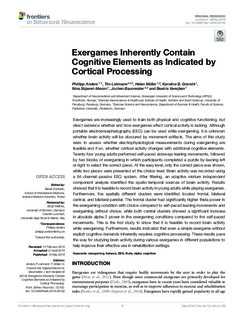| dc.contributor.author | Anders, Phillipp | |
| dc.contributor.author | Lehmann, Tim | |
| dc.contributor.author | Müller, Helen | |
| dc.contributor.author | Grønvik, Karoline Blix | |
| dc.contributor.author | Skjæret-Maroni, Nina | |
| dc.contributor.author | Baumeister, Jochen | |
| dc.contributor.author | Vereijken, Beatrix | |
| dc.date.accessioned | 2018-05-23T08:49:51Z | |
| dc.date.available | 2018-05-23T08:49:51Z | |
| dc.date.created | 2018-05-22T13:32:40Z | |
| dc.date.issued | 2018 | |
| dc.identifier.issn | 1662-5153 | |
| dc.identifier.uri | http://hdl.handle.net/11250/2498819 | |
| dc.description.abstract | Exergames are increasingly used to train both physical and cognitive functioning, but direct evidence whether and how exergames affect cortical activity is lacking. Although portable electroencephalography (EEG) can be used while exergaming, it is unknown whether brain activity will be obscured by movement artifacts. The aims of this study were to assess whether electrophysiological measurements during exergaming are feasible and if so, whether cortical activity changes with additional cognitive elements. Twenty-four young adults performed self-paced sideways leaning movements, followed by two blocks of exergaming in which participants completed a puzzle by leaning left or right to select the correct piece. At the easy level, only the correct piece was shown, while two pieces were presented at the choice level. Brain activity was recorded using a 64-channel passive EEG system. After filtering, an adaptive mixture independent component analysis identified the spatio-temporal sources of brain activity. Results showed that it is feasible to record brain activity in young adults while playing exergames. Furthermore, five spatially different clusters were identified located frontal, bilateral central, and bilateral parietal. The frontal cluster had significantly higher theta power in the exergaming condition with choice compared to self-paced leaning movements and exergaming without choice, while both central clusters showed a significant increase in absolute alpha-2 power in the exergaming conditions compared to the self-paced movements. This is the first study to show that it is feasible to record brain activity while exergaming. Furthermore, results indicated that even a simple exergame without explicit cognitive demands inherently requires cognitive processing. These results pave the way for studying brain activity during various exergames in different populations to help improve their effective use in rehabilitation settings. | nb_NO |
| dc.language.iso | eng | nb_NO |
| dc.publisher | Frontiers Media | nb_NO |
| dc.rights | Navngivelse 4.0 Internasjonal | * |
| dc.rights.uri | http://creativecommons.org/licenses/by/4.0/deed.no | * |
| dc.title | Exergames Inherently Contain Cognitive Elements as Indicated by Cortical Processing | nb_NO |
| dc.type | Journal article | nb_NO |
| dc.type | Peer reviewed | nb_NO |
| dc.description.version | publishedVersion | nb_NO |
| dc.source.volume | 12 | nb_NO |
| dc.source.journal | Frontiers in Behavioral Neuroscience | nb_NO |
| dc.identifier.doi | 10.3389/fnbeh.2018.00102 | |
| dc.identifier.cristin | 1585949 | |
| dc.description.localcode | Copyright © 2018 Anders, Lehmann, Müller, Grønvik, Skjæret-Maroni, Baumeister and Vereijken. This is an open-access article distributed under the terms of the Creative Commons Attribution License (CC BY). | nb_NO |
| cristin.unitcode | 194,65,30,0 | |
| cristin.unitname | Institutt for nevromedisin og bevegelsesvitenskap | |
| cristin.ispublished | true | |
| cristin.fulltext | original | |
| cristin.qualitycode | 1 | |

